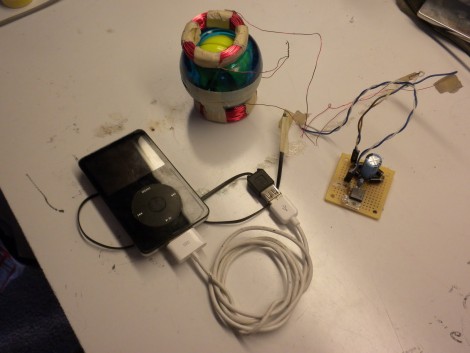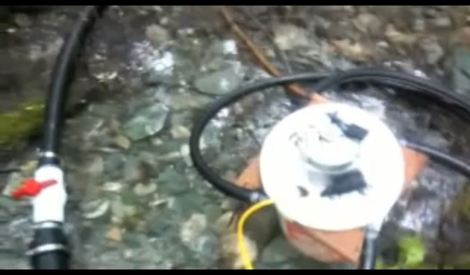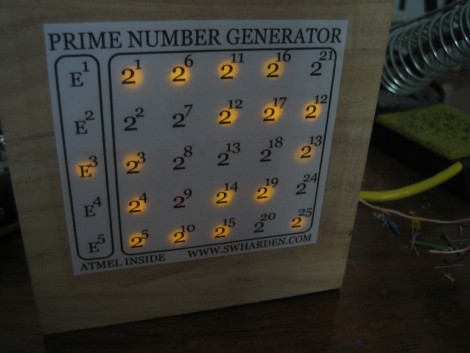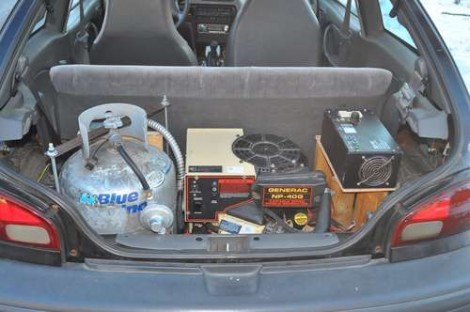[Ben Nelson] turned his electric Geo Metro into a plug-in hybrid. But wait, where’d he get an electric Geo Metro? It seems that we’re one hack behind [Ben], who converted the vehicle to all electric back in 2008 using a forklift motor and some batteries. This time around he’s following the Chevrolet Volt’s example by adding a backup generator. Instead of going with a gasoline power he added a tank of propane and the generator from a Recreational Vehicle. This won’t put out enough juice to drive while the generator is running, but you can use it to extend your traveling range by pulling over for a nap while it tops off the batteries.
generator107 Articles
Ridiculous Exerciser Becomes Useful As A Charger

[Scott Nietfeld] built a charger from a Dyna-flex wrist exerciser. We hadn’t heard of a these gyroscopic devices before but once we saw the promo video (embedded after the break) we realized that this is the kind of thing that infomercials were made to sell. [Scott] knew the internals spun to fairly high RPM and figured that adding a few magnets on the inside and coils on the outside would turn this thing into a generator. Four rare-earth magnets fit the bill, with two external coils feeding a rectifier and linear regulator. Below you can see his demonstration video where he takes the orb apart, then spins it up, generating 250 mA at about 7.5 volts to drive the regulator and charge a cellphone. Not bad!
Continue reading “Ridiculous Exerciser Becomes Useful As A Charger”
Marx Generator, Knocks Our Rocks Off

What weighs more than 500 pounds, produces 500 kilovolts, and we don’t recommend you try at home in any way shape or form? If you guessed a rock disaggregation device, you’re correct! We also accepted lightning generators as correct answers. Using high voltage electricity, a rock can be split apart down to its grains without destroying the precious minerals inside; unlike traditional grinding and mechanical techniques that often ruin the sample. All it takes is a massive hydro pole transformer, five 1uf 100 kilovolt capacitors, eight hand wound inductors, and two massive cojones to stand within 20 feet of the thing while it’s going off. Video after the divide.
Bicycle Hub Hydropower

[Niklas Roy] wanted to create electricity from moving water so he came up with this hyrdopower generator. It is part of his grand scheme to rent out small personal fountains made from buckets. They need electricity to run so he hooked up the generator to the water jet of a public fountain. It should be possible to use this setup with falling water in a similar way that other generators do.
To build the device he cut fins out of PVC pipe to use as the scoops. They are attached to a Shimano hub generator, meant for producing power while you pedal. The hub is mounted in the front for from a bicycle, which can then be mounted anywhere moving water is available. The only thing that worries us about the setup is [Niklas’] comment that being showered with water didn’t destroy the hub right away.
See the hub and the smaller fountains in the clip after the break.
Hydropower Generator

[Paul] wanted to have access to renewable energy at his cabin. It’s a relaxing place, nestled in a tall forest that shelters him from the sun and wind. This also means that solar and wind energy aren’t an option. But there is a stream running through the property so he decided to build his own version of a small water-powered generator.
He tapped into a reservoir about 200 feet upstream, split the flow into four smaller hoses, and channeled that into a five-gallon bucket. Inside the bucket you’ll find a Pelton wheel he built which turns a low-RPM generator. He manages to generate 56 VDC at 10 A with this setup, more than enough to charge a bank of batteries.
He does a great job of explaining his setup in the video after the break. If you’re looking for other ideas of how to cut down on your environmental impact check out this compost-powered water heater.
ATtiny2313 Prime Number Generator

[Scott Harden’s] prime number generator exhibits a great way to use an LED matrix to present readable information. The project resides in a hinged wooden box with a grid of holes on the lid for the LEDs. [Scott] has overlaid the matrix with a printout showing powers of two that represent different prime numbers. Inside you’ll find an ATtiny2313 microcontroller that handles the column scanning and prime number testing. We’ve embedded a video the break where [Scott] explains the project in great detail, but you should also check out his prototyping and construction pages.
Homemade Induction Generator
[youtube=http://www.youtube.com/watch?v=RTTgLYzfQrE]
[Tyler LaVite] tipped us off about the generator he built. He combined a 5.5 horsepower Honda motor with a 10 horsepower electric bandsaw motor. To get an induction generator to produce alternating current you must feed electricity into the system to start the magnetic flux. [Tyler’s] solution was to include a bank of capacitors totaling 230mF which charge from the motor, then release back into the system. It’s not as green as the syngas generators we’ve seen since it still uses fossil fuel, but it reuses old parts sending less to the landfill.











